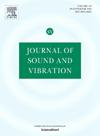Toward online stability margin tracking of Turbomachines via operational modal analysis
IF 4.3
2区 工程技术
Q1 ACOUSTICS
引用次数: 0
Abstract
Proper design and monitoring of turbomachines are highly important for efficient and safe operation in industry. In the special case of turbomachines that contain seals, it is important to predict and avoid the steam whirl phenomenon. Steam whirl occurs when negative damping effects overtake positive damping effects, which leads to instability due to lateral vibration. The power level in which this phenomenon occurs sets the stability margin of the turbomachine. Predicting this phenomenon usually comprises modeling and testing machines during the design and commissioning stages. Design is quite challenging considering that accurate mathematical models are difficult to obtain and valid over a given operational range. Moreover, design and commissioning do not encompass changes due to deterioration and possible damage, which can change the stability margin during the machine's operation. Operational Modal Analysis (OMA) is used to extract modal parameters of systems during operation, with most applications related to civil structures. Turbomachines, in general, are non-linear and time-varying systems subjected to harmonic excitation, which hampers modal identification via OMA. Nevertheless, recent studies show that OMA's techniques have a lot of potential to support the condition monitoring of these systems. To contribute to this topic, this research proposes the estimation and tracking of the stability margin of a turbomachine with seals via Automated OMA (AOMA). Vibration signals from a turbomachine composed of a rotor supported by active magnetic bearings and containing annular gas seals are employed. The results show that different excitation conditions are required for modal identification and when adjusting these conditions, it is possible to extract good estimates of modes related to the foundation and the rotor, including the one that defines the instability margin. AOMA proves to be a promising tool for identifying the stability margin of turbomachines during operation, being valuable for condition monitoring.

通过运行模态分析实现涡轮机械的在线稳定裕度跟踪
本文章由计算机程序翻译,如有差异,请以英文原文为准。
求助全文
约1分钟内获得全文
求助全文
来源期刊

Journal of Sound and Vibration
工程技术-工程:机械
CiteScore
9.10
自引率
10.60%
发文量
551
审稿时长
69 days
期刊介绍:
The Journal of Sound and Vibration (JSV) is an independent journal devoted to the prompt publication of original papers, both theoretical and experimental, that provide new information on any aspect of sound or vibration. There is an emphasis on fundamental work that has potential for practical application.
JSV was founded and operates on the premise that the subject of sound and vibration requires a journal that publishes papers of a high technical standard across the various subdisciplines, thus facilitating awareness of techniques and discoveries in one area that may be applicable in others.
 求助内容:
求助内容: 应助结果提醒方式:
应助结果提醒方式:


